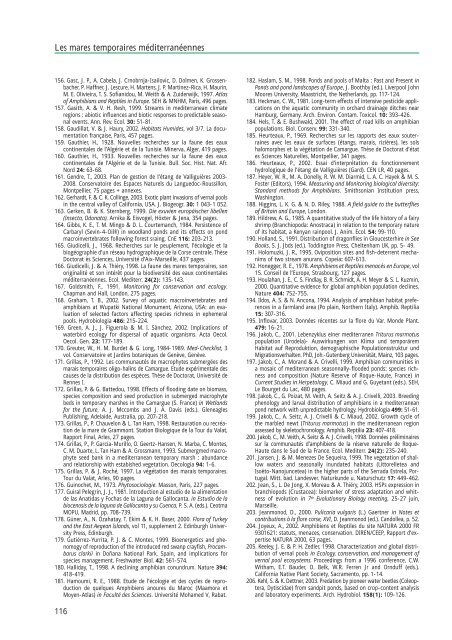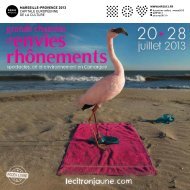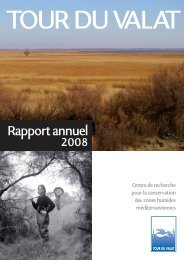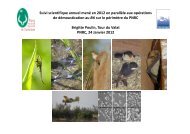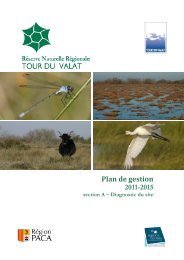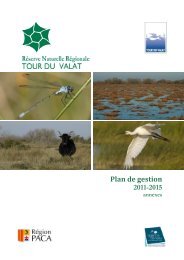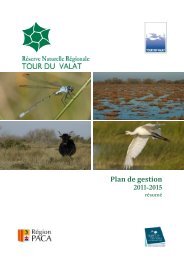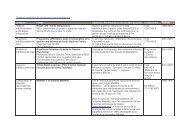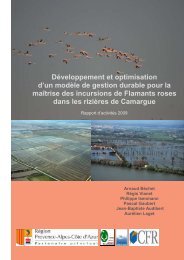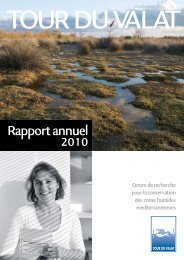Les mares temporaires méditerranéennes Volume 1
Les mares temporaires méditerranéennes Volume 1
Les mares temporaires méditerranéennes Volume 1
You also want an ePaper? Increase the reach of your titles
YUMPU automatically turns print PDFs into web optimized ePapers that Google loves.
<strong>Les</strong> <strong>mares</strong> <strong>temporaires</strong> méditerranéennes156. Gasc, J. P., A. Cabela, J. Crnobrnja-Isailovic, D. Dolmen, K. Grossenbacher,P. Haffner, J. <strong>Les</strong>cure, H. Martens, J. P. Martinez-Rica, H. Maurin,M. E. Olivieira, T. S. Sofianidou, M. Weith & A. Zuiderwijk, 1997. Atlasof Amphibians and Reptiles in Europe. SEH & MNHM, Paris, 496 pages.157. Gasith, A. & V. H. Resh, 1999. Streams in mediterranean climateregions : abiotic influences and biotic responses to predictable seasonalevents. Ann. Rev. Ecol. 30: 51-81.158. Gaudillat, V. & J. Haury, 2002. Habitats Humides, vol 3/7. La documentationfrançaise, Paris, 457 pages.159. Gauthier, H., 1928. Nouvelles recherches sur la faune des eauxcontinentales de l’Algérie et de la Tunisie. Minerva, Alger, 419 pages.160. Gauthier, H., 1933. Nouvelles recherches sur la faune des eauxcontinentales de l’Algérie et de la Tunisie. Bull. Soc. Hist. Nat. Afr.Nord 24: 63-68.161. Gendre, T., 2003. Plan de gestion de l’étang de Valliguières 2003-2008. Conservatoire des Espaces Naturels du Languedoc-Roussillon,Montpellier, 75 pages + annexes.162. Gerhardt, F. & C. K. Collinge, 2003. Exotic plant invasions of vernal poolsin the central valley of California, USA. J. Biogeogr. 30: 1 043-1 052.163. Gerken, B. & K. Sternberg, 1999. Die exuvien europäischer libellen(Insecta, Odonata). Arnika & Eisvogel, Höxter & Jena, 354 pages.164. Gibbs, K. E., T. M. Mingo & D. L. Courtemanch, 1984. Persistence ofCarbaryl (Sevin-4-Oil®) in woodland ponds and its effects on pondmacroinvertebrates following forest sraing. CnE 116: 203-213.165. Giudicelli, J., 1968. Recherches sur le peuplement, l’écologie et labiogéographie d’un réseau hydrographique de la Corse centrale. ThèseDoctorat ès Sciences, Université d’Aix-Marseille, 437 pages.166. Giudicelli, J. & A. Thiéry, 1998. La faune des <strong>mares</strong> <strong>temporaires</strong>, sonoriginalité et son intérêt pour la biodiversité des eaux continentalesméditerranéennes. Ecol. Mediterr. 24(2): 135-143.167. Goldsmith, F., 1991. Monitoring for conservation and ecology.Chapman and Hall, London, 275 pages.168. Graham, T. B., 2002. Survey of aquatic macroinvertebrates andamphibians at Wupatki National Monument, Arizona, USA: an evaluationof selected factors affecting species richness in ephemeralpools. Hydrobiologia 486: 215-224.169. Green, A. J., J. Figuerola & M. I. Sànchez, 2002. Implications ofwaterbird ecology for dispersal of aquatic organisms. Acta Oecol.Oecol. Gen. 23: 177-189.170. Greuter, W., H. M. Burdet & G. Long, 1984-1989. Med-Checklist, 3vol. Conservatoire et Jardins botaniques de Genève, Genève.171. Grillas, P., 1992. <strong>Les</strong> communautés de macrophytes submergées desmarais <strong>temporaires</strong> oligo-halins de Camargue. Etude expérimentale descauses de la distribution des espèces. Thèse de Doctorat, Université deRennes I.172. Grillas, P. & G. Battedou, 1998. Effects of flooding date on biomass,species composition and seed production in submerged macrophytebeds in temporary marshes in the Camargue (S. France) in Wetlandsfor the future, A. J. Mccombs and J. A. Davis (eds.). GleneaglesPublishing, Adelaide, Australia, pp. 207-218.173. Grillas, P., P. Chauvelon & L. Tan Ham, 1998. Restauration ou recréationde la mare de Grammont. Station Biologique de la Tour du Valat,Rapport Final, Arles, 27 pages.174. Grillas, P., P. Garcia-Murillo, O. Geertz-Hansen, N. Marba, C. Montes,C. M. Duarte, L. Tan Ham & A. Grossmann, 1993. Submergmed macrophyteseed bank in a mediterranean temporary marsh : abundanceand relationship with estabished vegetation. Oecologia 94: 1-6.175. Grillas, P. & J. Roché, 1997. La végétation des marais <strong>temporaires</strong>.Tour du Valat, Arles, 90 pages.176. Guinochet, M., 1973. Phytosociologie. Masson, Paris, 227 pages.177. Guiral Pelegrin, J. J., 1981. Introduction al estudio de la alimentationde las Anatidas y Fochas de la Laguna de Gallocanta. in Estudio de labiocenosis de la laguna de Gallocanta y su Cuenca, P. S. A. (eds.). CeotmaMOPU, Madrid, pp. 708-739.178. Güner, A., N. Özahatay, T. Ekim & K. H. Baser, 2000. Flora of Turkeyand the East Aegean Islands, vol 11, supplement 2. Edinburgh UniversityPress, Edinburgh.179. Gutiérrez-Yurrita, P. J. & C. Montes, 1999. Bioenergetics and phenomogyof reproduction of the introduced red swanp crayfish, Procambarusclarkii in Doñana National Park, Spain, and implications forspecies management. Freshwater Biol. 42: 561-574.180. Halliday, T., 1998. A declining amphibian conundrum. Nature 394:418-419.181. Hamoumi, R. E., 1988. Etude de l’écologie et des cycles de reproductionde quelques Amphibiens anoures du Maroc (Maamora etMoyen-Atlas) in Faculté des Sciences. Université Mohamed V, Rabat.182. Haslam, S. M., 1998. Ponds and pools of Malta : Past and Present inPonds and pond landscapes of Europe, J. Boothby (ed.). Liverpool JohnMoores University, Maastricht, the Netherlands, pp. 117-124.183. Heckman, C. W., 1981. Long-term effects of intensive pesticide applicationson the aquatic community in orchard drainage ditches nearHamburg, Germany. Arch. Environ. Contam. Toxicol. 10: 393-426.184. Hels, T. & E. Bushwald, 2001. The effect of road kills on amphibianpopulations. Biol. Conserv. 99: 331-340.185. Heurteaux, P., 1969. Recherches sur les rapports des eaux souterrainesavec les eaux de surfaces (étangs, marais, rizières), les solshalomorphes et la végétation de Camargue. Thèse de Doctorat d’étates Sciences Naturelles, Montpellier, 341 pages.186. Heurteaux, P., 2002. Essai d’interprétation du fonctionnementhydrologique de l’étang de Valliguières (Gard). CEN LR, 40 pages.187. Heyer, W. R., M. A. Donelly, R. W. M. Diarmid, L. A. C. Hayek & M. S.Foster (Editors), 1994. Measuring and Monitoring biological diversity:Standard methods for Amphibians. Smithsonian Institution press,Washington.188. Higgins, L. K. G. & N. D. Riley, 1988. A field guide to the butterfliesof Britain and Europe, London.189. Hildrew, A. G., 1985. A quantitative study of the life history of a fairyshrimp (Branchiopoda: Anostraca) in relation to the temporary natureof its habitat, a Kenyan rainpool. J. Anim. Ecol. 54: 99-110.190. Holland, S., 1991. Distribution of dragonflies in Gloucesterhire in SeeBooks, S. J. Jbds (ed.). Toddington Press, Cheltenham UK, pp. 5- 49.191. Holomuzki, J. R., 1995. Oviposition sites and fish-deterrent mechanimsof two stream anurans. Copeia: 607-613.192. Honegger, R. E., 1978. Amphibiens et Reptiles menacés en Europe, vol15. Conseil de l’Europe, Strasbourg, 127 pages.193. Houlahan, J. E., C. S. Findlay, B. R. Schmidt, A. H. Meyer & S. L. Kuzmin,2000. Quantitative evidence for global amphibian population declines.Nature 404: 752-755.194. Ildos, A. S. & N. Ancona, 1994. Analysis of amphibian habitat preferencesin a farmland area (Po plain, Northern Italy). Amphib. Reptilia15: 307-316.195. Inflovar, 2003. Données récentes sur la flore du Var. Monde Plant.479: 16-21.196. Jakob, C., 2001. Lebenzyklus einer mediterranen Triturus marmotuspopulation (Urodela)- Auswirkungen von Klima und temporäremHabitat auf Reproduktion, demographische Populationsstruktur undMigrationsverhalten. PhD, Joh.-Gutenberg Universität, Mainz, 103 pages.197. Jakob, C., A. Morand & A. Crivelli, 1999. Amphibian communities ina mosaic of mediterranean seasonnally-flooded ponds: species richnessand composition (Nature Reserve of Roque-Haute, France) inCurrent Studies in Herpetology, C. Miaud and G. Guyetant (eds.). SEH,Le Bourget du Lac, 480 pages.198. Jakob, C., G. Poizat, M. Veith, A. Seitz & A. J. Crivelli, 2003. Breedingphenology and larval distribution of amphibians in a mediterraneanpond network with unpredictable hydrology. Hydrobiologia 499: 51-61.199. Jakob, C., A. Seitz, A. J. Crivelli & C. Miaud, 2002. Growth cycle ofthe marbled newt (Triturus marmotus) in the mediterranean regionassessed by skeletochronology. Amphib. Reptilia 23: 407-418.200. Jakob, C., M. Veith, A. Seitz & A. J. Crivelli, 1998. Données préliminairessur la communautés d’amphibiens de la réserve naturelle de Roque-Haute dans le Sud de la France. Ecol. Mediterr. 24(2): 235-240.201. Jansen, J. & M. Menezes De Sequeira, 1999. The vegetation of shallowwaters and seasonally inundated habitats (Littorelletea andIsoëto-Nanojuncetea) in the higher parts of the Serrada Estrela, Portugal.Mitt. bad. Landesver. Naturkunde u. Naturschutz 17: 449-462.202. Jean, S., L. De Jong, X. Moreau & A. Thiéry, 2003. HSPs expression inbranchiopods (Crustacea): biomarker of stress adaptation and whitnessof evolution in 7 th Evolutionary Biology meeting, 25-27 juin,Marseille.203. Jeanmonod, D., 2000. Pulicaria vulgaris (L.) Gaertner in Notes etcontributions à la flore corse, XVI, D. Jeanmonod (ed.). Candollea, p. 52.204. Joyeux, A., 2002. Amphibiens et Reptiles du site NATURA 2000 FR9301621: statuts, menaces, conservation. DIREN/CEEP, Rapport d’expertiseNATURA 2000, 63 pages.205. Keeley, J. E. & P. H. Zedler, 1998. Characterization and global distributionof vernal pools in Ecology, conservation, and management ofvernal pool ecosystems. Proceedings from a 1996 conference, C.W.Witham, E.T. Bauder, D. Belk, W.R. Ferren Jr and Ornduff (eds.).California Native Plant Society, Sacramento, pp. 1-14.206. Kehl, S. & K. Dettner, 2003. Predation by pioneer water beetles (Coleoptera,Dytiscidae) from sandpit ponds, based on crop-content analysisand laboratory experiments. Arch. Hydrobiol. 158(1): 109-126.116


